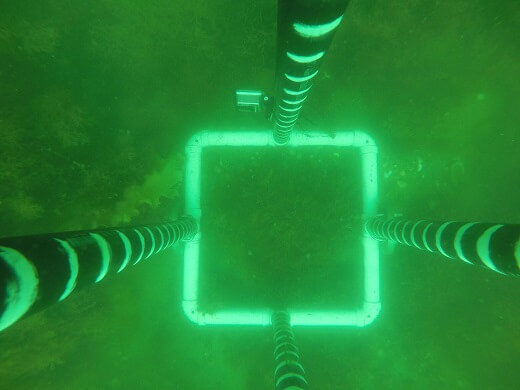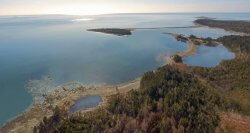It is just over a year since Dr. Lori Marino and I announced that Port Hilford Bay in Nova Scotia would be the location of a gold-standard sanctuary that will provide for captive whales to be retired and given a new life.
And now, after a year of site development work, we’re delighted to have reached the next important milestone: deciding the specific placement of the sanctuary within this large bay.
The sanctuary site will encompass this extensive area of approximately 110 acres of ocean around Barachois Island in Port Hilford Bay, Nova Scotia.
There have been two main elements to reaching this next stage. The first involved several months of gathering environmental data to understand as much as possible about every aspect of the bay and its surrounding land. That’s because the 110 acres that will be the whales’ home need to be in an environment that’s interesting, varied and enriching, safe and healthy both for them and for all the other living creatures who inhabit the bay. For example, it should be deep in some places and shallow in others; with a sandy sea floor in some parts and a variable sea floor in others – rich in plant and animal life and basically a place the whales can truly call home.
To understand all of this, we’ve been documenting water depths around the bay, along with the nature of the seafloor below, and testing the water chemistry, the salinity, the temperature gradients, water flow transfer rates and freshwater egress into the bay. Most recently, we completed the hydrodynamic model, which tells us what we need to know about currents, tides, waves and surges so that we can position the sanctuary very precisely and place the nets accordingly.

One of the instruments used in developing the hydrodynamic model.
The second aspect of site development has involved understanding how the sanctuary can work most successfully with all the people who have an interest in the bay and a relationship to it. These include the local communities of Port Hilford, Wine Harbour, and Sherbrooke and the district of St Mary’s; the people who live and work on the bay; the Mi’kmaq Nation; the federal, provincial and local officials who are charged with issuing the necessary permits; and with other interested people and organizations of all kinds throughout Nova Scotia.
Bringing it all together during a pandemic

Accomplishing all of this has been something of a challenge in that right on the heels of our announcing Port Hilford as the location for the sanctuary, the COVID-19 virus all but shut down travel between the United States and Canada (and even between Nova Scotia and the rest of Canada). That made the next stage of our work a lot more complicated. But with lots of teleconferencing, along with help and support from the local community, we were able to press ahead.
Finally, just two weeks ago, it all came together. And at a community meeting in Sherbrooke, Nova Scotia, Lori Marino and I were delighted to announce that the sanctuary will be located in 110 acres of ocean around the wharf near the mouth of Port Hilford Bay.
This location has the full support of the fishermen who moor their boats at the wharf and fish for lobsters in the waters nearby. They are truly rolling up their sleeves with us. And while we’re no longer surprised by that level of support, it is just terrific.
We have also reached an agreement in principle – subject to our having all the governmental permitting in place – to purchase prime coastline that will border the sanctuary waters and provide a highly enriching area for the whales as well as exclusive use of the wharf.
It has the deepest water – 18 meters of depth off Barachois Island – and shallows as well. There’s a lot of variety in the substrate and the coast, which is exactly what’s needed for a whale sanctuary.
Next stages
Being able to settle on a specific location within Port Hilford Bay leads us into the next stage of permitting with the Nova Scotia Department of Lands and Forestry.
It also means we must immediately be even more active in raising the funds necessary to build the sanctuary itself. I look forward to describing this in more detail. And with your continuing help, we look forward to being able to welcome the first whales by the end of next year.
Thank you, as always, for making this such a unique opportunity for the whales. Together, we can give them a new life that makes up for so much of what they have endured.
* * *
